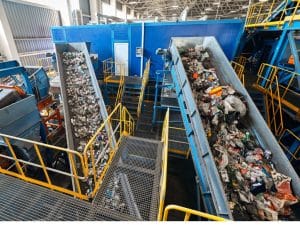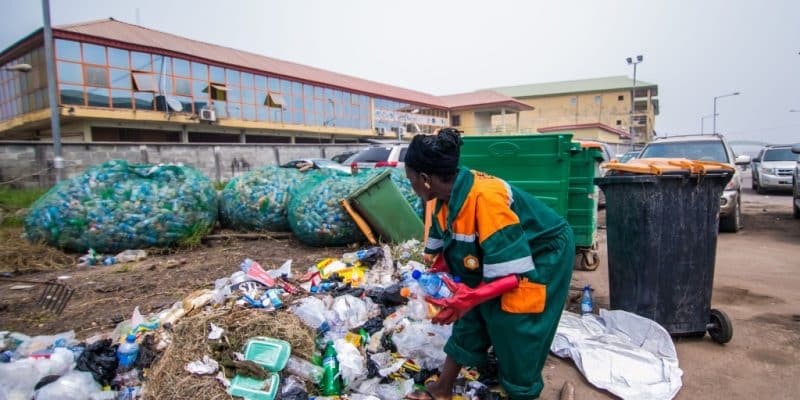According to a recent MarketsandMarkets™ report, the global waste management market reached $1219.6 billion in 2024 and could grow to $1598.1 billion by 2029. While this investment is proof that this issue is being better considered when it comes to developing funding policies, it is more significant in that it prioritises sustainable waste management projects, with the aim of contributing to climate action, particularly in Africa. On the occasion of the World Circular Economy Forum, which opened in Brussels on 15 April 2024, Afrik 21 assesses the effectiveness of this approach on the African continent, which goes well beyond recycling, and discusses the opinions of experts with a view to accelerating the circular economy.
Sustainable sourcing, eco-design, industrial and territorial ecology, the functionality economy, responsible consumption, extended useful life and waste recycling. These seven points sum up the circular economy, a practice that aims to extend the life cycle of products in order to reduce the consumption of raw materials and the production of waste. While a few years ago the primary objective was to preserve natural resources and protect the environment from pollution caused by waste, the circular economy has evolved and now aims to serve a more important cause for the planet: the fight against global warming.
“The circular economy can make a significant contribution to climate action by reducing greenhouse gas (GHG) emissions by 60% by 2050,” stated the African Development Bank (AfDB) at the time in a report published on 21 December 2023. Among these GHGs is carbon dioxide (CO2), which accounts for 2/3 of global GHG emissions, with energy, transport, industry, construction and other sectors being the biggest emitters. Methane (CH4) is 80 times more potent than CO2, and the second best-known GHG is responsible for 30% of global warming since the pre-industrial era. It is largely produced by the agricultural sector through ruminant breeding, fossil fuels and the biological process of methanisation, etc. Less frequently mentioned, nitrous oxide is no less problematic. This GHG has a global warming potential almost 300 times greater than CO2 and is known to cause the destruction of stratospheric ozone.
So GHG emissions are the crux of the problem
Although Africa only emits 4% of GHGs, it is unfortunately more exposed than other continents to the effects of climate change and variability, hence the continent’s interest in contributing to climate action, in particular by strengthening the practice of the circular economy, which is not new to the continent.
Unlike more developed societies, Africans have always practised it consciously or unconsciously, avoiding waste and favouring the repair, reuse and sharing of objects and materials. In Ouagadougou, Burkina Faso, in 1996, for example, the “Na-Yiri” (official residences of the kings) were central buildings of the Sudano-Sahelian type, rectangular in shape, made up of banco walls and earthen roofs covering mats, themselves supported by split wooden slats and held up by beams made from tree trunks. Why were these natural materials chosen? It was because the kings wanted their ‘Na-Yiri’ to be solid and last even after their death. Today, we use more industrial materials that pollute the environment.
So the circular economy is just another name for this conservation practice, which is ultimately African.
The circular economy, much more focused on waste recovery in Africa today
Egypt, Morocco, Tunisia, Nigeria, South Africa, Ghana, Kenya, Rwanda, Senegal, Ivory Coast and Namibia are the model countries for waste recovery (from households, agriculture, industry, mobility, construction, etc.) in Africa, in particular as energy, fertiliser for agriculture, secondary raw materials, etc. Countries such as Cameroon, Congo, the Democratic Republic of Congo (DRC), Chad, Gabon, Togo, Burkina Faso, Burundi, Ethiopia, Guinea, Benin, etc. are slightly less advanced.

A solid-waste recycling plant©Nordroden/Shutterstock
And among the countries where sustainable waste management is virtually non-existent are Djibouti, South Sudan, Somalia, Libya, Lesotho and others. Perhaps they are unaware of the potential of the circular economy or do not all have a strategy for implementing it. However, by applying the circular economy, these countries would become less vulnerable to climate shocks, particularly by reducing GHG emissions. “Africa not only has the opportunity to fight climate change, but also to position itself as a global solution to address the climate crisis,” said Anthony Nyong, the AfDB’s director of climate change and green growth in a report published on 21 December 2023. Currently, the circular economy represents an annual market of just $8 billion in Africa in 2023, an insignificant figure compared to the $1219.6 billion reached by the global waste management market in 2024 according to a report by MarketsandMarkets™, one of the world’s largest revenue impact firms, serving more than 10,000 clients.
In an interview with Afrik 21 in December 2022, Jocelyne Landry Tsonang, the representative of the African Circular Economy Network (Acen) in Cameroon and associate consultant for the Acen Foundation suggested at the time the “formalisation of the circular economy in Africa so that people, voluntarily or not, can practise it”. In addition to waste management, this would mean ensuring the sustainability of a product’s production and consumption chain.
Access to finance can also accelerate the circular economy in Africa
All categories of players need to be made aware of their role in preserving the environment. But for this to happen, real political will is needed, especially as the benefits of applying this approach are limitless. According to Jocelyne Landry Tsonang, this political will will encourage innovation and job creation, and help solve health and environmental problems.

A car made with sustainable materials©Scharfsinn/Shutterstock
Today on the African continent, many small and medium-sized enterprises (SMEs) are involved in circular economy activities. But in many countries, they are not supported: there are no incentive policies or funding to encourage their development.
In addition, many African countries (Nigeria, Tanzania, Senegal) have committed to banning single-use plastic packaging. But many countries are finding it very difficult to implement this ban, due to a lack of funding for the transition and the absence of coercive measures. “We need to strengthen partnerships and alliances in order to define common objectives and mobilise the resources needed to finance implementation”, also suggested Rose Mwebaza, Regional Director and Representative of the United Nations Environment Programme (UNEP) in Africa, at a round table organised on the sidelines of the 28th United Nations Conference of the Parties on Climate Change (COP28).
If these conditions are met, Africa could make a significant contribution to climate action. But at the same time, the major polluting countries (China, the United States and India) will have to step up their circularity by promoting eco-responsible production and consumption to avoid dragging the African continent down. At present, the extraction and use of materials still account for 70% of global greenhouse gas emissions.
Inès Magoum








You must be logged in to post a comment.